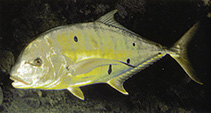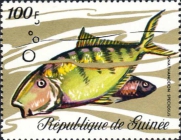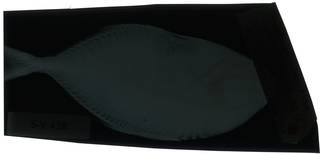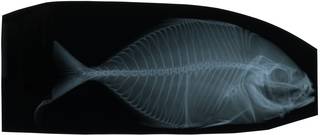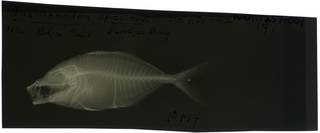Deep-Sea taxon details
Gnathanodon speciosus (Forsskål, 1775)
218429 (urn:lsid:marinespecies.org:taxname:218429)
accepted
Species
Caranx speciosus (Forsskål, 1775) · unaccepted
marine, brackish, fresh, terrestrial
(of ) Niebuhr, C. (1775). Descriptiones animalium avium, amphibiorum, piscium, insectorum, vermium; quae in itinere orientali observavit Petrus Forskål. <em>Post mortem auctoris edidit Carsten Niebuhr. Hauniae.</em> 1-20 + i-xxxiv + 1-164, map. [Pisces on pp. x-xix and 22-76]., available online at http://www.biodiversitylibrary.org/item/18564
page(s): 54, xii [details]
page(s): 54, xii [details]
Description Forms schools. Occurs in deep lagoons and seaward reefs where they feed by rooting for crustaceans and other invertebrates...
Description Forms schools. Occurs in deep lagoons and seaward reefs where they feed by rooting for crustaceans and other invertebrates in the sand. Also feeds on small fishes. Juveniles are often found on reefs (Ref. 9283). It is noted for its behaviour to closely swim around other large fish, but also following divers (Ref. 10361).The species in never toxic (Ref. 4795). Marketed fresh and salted/dried (Ref.9283). Juveniles are used in the aquarium trade. [details]
Froese, R. and D. Pauly. Editors. (2024). FishBase. Gnathanodon speciosus (Forsskål, 1775). Accessed through: Glover, A.G.; Higgs, N.; Horton, T. (2024) World Register of Deep-Sea species (WoRDSS) at: https://marinespecies.org/DeepSea/aphia.php?p=taxdetails&id=218429 on 2024-04-24
Glover, A.G.; Higgs, N.; Horton, T. (2024). World Register of Deep-Sea species (WoRDSS). Gnathanodon speciosus (Forsskål, 1775). Accessed at: https://www.marinespecies.org/deepsea/aphia.php?p=taxdetails&id=218429 on 2024-04-24
Date
action
by
original description
(of ) Niebuhr, C. (1775). Descriptiones animalium avium, amphibiorum, piscium, insectorum, vermium; quae in itinere orientali observavit Petrus Forskål. <em>Post mortem auctoris edidit Carsten Niebuhr. Hauniae.</em> 1-20 + i-xxxiv + 1-164, map. [Pisces on pp. x-xix and 22-76]., available online at http://www.biodiversitylibrary.org/item/18564
page(s): 54, xii [details]
context source (Deepsea) Intergovernmental Oceanographic Commission (IOC) of UNESCO. The Ocean Biogeographic Information System (OBIS), available online at http://www.iobis.org/ [details]
context source (HKRMS) Hong Kong marine fish database. <em>AFCD.</em> , available online at https://www.hk-fish.net/en/fish/introduction/ [details]
basis of record Froese, R. & D. Pauly (Editors). (2023). FishBase. World Wide Web electronic publication. version (02/2023)., available online at https://www.fishbase.org [details]
additional source Liu, J.Y. [Ruiyu] (ed.). (2008). Checklist of marine biota of China seas. <em>China Science Press.</em> 1267 pp. (look up in IMIS) [details] Available for editors
ecology source Looby, A.; Erbe, C.; Bravo, S.; Cox, K.; Davies, H. L.; Di Iorio, L.; Jézéquel, Y.; Juanes, F.; Martin, C. W.; Mooney, T. A.; Radford, C.; Reynolds, L. K.; Rice, A. N.; Riera, A.; Rountree, R.; Spriel, B.; Stanley, J.; Vela, S.; Parsons, M. J. G. (2023). Global inventory of species categorized by known underwater sonifery. <em>Scientific Data.</em> 10(1). (look up in IMIS), available online at https://doi.org/10.1038/s41597-023-02745-4 [details]
page(s): 54, xii [details]
context source (Deepsea) Intergovernmental Oceanographic Commission (IOC) of UNESCO. The Ocean Biogeographic Information System (OBIS), available online at http://www.iobis.org/ [details]
context source (HKRMS) Hong Kong marine fish database. <em>AFCD.</em> , available online at https://www.hk-fish.net/en/fish/introduction/ [details]
basis of record Froese, R. & D. Pauly (Editors). (2023). FishBase. World Wide Web electronic publication. version (02/2023)., available online at https://www.fishbase.org [details]
additional source Liu, J.Y. [Ruiyu] (ed.). (2008). Checklist of marine biota of China seas. <em>China Science Press.</em> 1267 pp. (look up in IMIS) [details] Available for editors
ecology source Looby, A.; Erbe, C.; Bravo, S.; Cox, K.; Davies, H. L.; Di Iorio, L.; Jézéquel, Y.; Juanes, F.; Martin, C. W.; Mooney, T. A.; Radford, C.; Reynolds, L. K.; Rice, A. N.; Riera, A.; Rountree, R.; Spriel, B.; Stanley, J.; Vela, S.; Parsons, M. J. G. (2023). Global inventory of species categorized by known underwater sonifery. <em>Scientific Data.</em> 10(1). (look up in IMIS), available online at https://doi.org/10.1038/s41597-023-02745-4 [details]
 Present
Present  Inaccurate
Inaccurate  Introduced: alien
Introduced: alien  Containing type locality
Containing type locality
From other sources
Description Forms schools. Occurs in deep lagoons and seaward reefs where they feed by rooting for crustaceans and other invertebrates in the sand. Also feeds on small fishes. Juveniles are often found on reefs (Ref. 9283). It is noted for its behaviour to closely swim around other large fish, but also following divers (Ref. 10361).The species in never toxic (Ref. 4795). Marketed fresh and salted/dried (Ref.9283). Juveniles are used in the aquarium trade. [details]
| Language | Name | |
|---|---|---|
| English | golden trevally | [details] |
| Japanese | コガネシマアジ | [details] |
| Spanish | jurel dorado | [details] |
To Barcode of Life (70 barcodes)
To Biodiversity Heritage Library (105 publications) (from synonym Caranx speciosus (Forsskål, 1775))
To Biodiversity Heritage Library (50 publications)
To Biological Information System for Marine Life (BISMaL)
To European Nucleotide Archive (ENA)
To FishBase (from synonym Caranx speciosus (Forsskål, 1775))
To FishBase
To FishBase images (Gnathanodon speciosus, by Randall, J.E.)
To GenBank (115 nucleotides; 88 proteins)
To Global Biotic Interactions (GloBI)
To IUCN Red List (Least Concern)
To NMNH Extant Collection (Gnathanodon speciosus RAD117253-001)
To NMNH Extant Collection (Gnathanodon speciosus RAD117256-001) (from synonym Caranx speciosus (Forsskål, 1775))
To NMNH Extant Collection (Gnathanodon speciosus RAD117257-001)
To ITIS
To Biodiversity Heritage Library (105 publications) (from synonym Caranx speciosus (Forsskål, 1775))
To Biodiversity Heritage Library (50 publications)
To Biological Information System for Marine Life (BISMaL)
To European Nucleotide Archive (ENA)
To FishBase (from synonym Caranx speciosus (Forsskål, 1775))
To FishBase
To FishBase images (Gnathanodon speciosus, by Randall, J.E.)
To GenBank (115 nucleotides; 88 proteins)
To Global Biotic Interactions (GloBI)
To IUCN Red List (Least Concern)
To NMNH Extant Collection (Gnathanodon speciosus RAD117253-001)
To NMNH Extant Collection (Gnathanodon speciosus RAD117256-001) (from synonym Caranx speciosus (Forsskål, 1775))
To NMNH Extant Collection (Gnathanodon speciosus RAD117257-001)
To ITIS
From editor or global species database
From other sources

